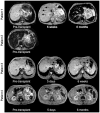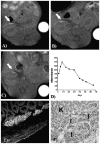Magnetic resonance imaging of cells in experimental disease models
- PMID: 21552511
- PMCID: PMC3087183
- DOI: 10.1016/j.pnmrs.2008.11.002
Magnetic resonance imaging of cells in experimental disease models
Figures









Similar articles
-
Longitudinal in vivo magnetic resonance imaging studies in experimental allergic encephalomyelitis: effect of a neurotrophic treatment on cortical lesion development.Neuroscience. 1997 Apr;77(4):1163-73. doi: 10.1016/s0306-4522(96)00514-3. Neuroscience. 1997. PMID: 9130795
-
Quantitative magnetic resonance imaging of chronic kidney disease: an experimental in vivo study using rat chronic kidney disease models.Acta Radiol. 2023 Jan;64(1):404-414. doi: 10.1177/02841851211065143. Epub 2021 Dec 20. Acta Radiol. 2023. PMID: 34928730
-
Rabbit models of intracranial atherosclerotic disease for pathological validation of vessel wall MRI.Neuroradiol J. 2021 Jun;34(3):193-199. doi: 10.1177/1971400920980153. Epub 2020 Dec 16. Neuroradiol J. 2021. PMID: 33325806 Free PMC article.
-
Diagnostic accuracy and clinical impact of MRI-based technologies for patients with non-alcoholic fatty liver disease: systematic review and economic evaluation.Health Technol Assess. 2023 Jul;27(10):1-115. doi: 10.3310/KGJU3398. Health Technol Assess. 2023. PMID: 37839810 Free PMC article.
-
Magnetic resonance of mouse models of cardiac disease.Handb Exp Pharmacol. 2008;(185 Pt 2):245-57. doi: 10.1007/978-3-540-77496-9_10. Handb Exp Pharmacol. 2008. PMID: 18626605 Review.
Cited by
-
In vivo Cell Tracking Using Non-invasive Imaging of Iron Oxide-Based Particles with Particular Relevance for Stem Cell-Based Treatments of Neurological and Cardiac Disease.Mol Imaging Biol. 2020 Dec;22(6):1469-1488. doi: 10.1007/s11307-019-01440-4. Mol Imaging Biol. 2020. PMID: 31802361 Review.
-
Magnetic resonance imaging of transplanted stem cell fate in stroke.J Res Med Sci. 2014 May;19(5):465-71. J Res Med Sci. 2014. PMID: 25097631 Free PMC article. Review.
-
Molecular imaging of microglia/macrophages in the brain.Glia. 2013 Jan;61(1):10-23. doi: 10.1002/glia.22357. Epub 2012 May 21. Glia. 2013. PMID: 22615180 Free PMC article. Review.
-
ICV-transplanted human glial precursor cells are short-lived yet exert immunomodulatory effects in mice with EAE.Glia. 2012 Jul;60(7):1117-29. doi: 10.1002/glia.22339. Epub 2012 Apr 12. Glia. 2012. PMID: 22499166 Free PMC article.
-
Magnetic nanoparticles for oligodendrocyte precursor cell transplantation therapies: progress and challenges.Mol Cell Ther. 2014 Jul 28;2:23. doi: 10.1186/2052-8426-2-23. eCollection 2014. Mol Cell Ther. 2014. PMID: 26056590 Free PMC article. Review.
References
-
- Mazzarello P. Nat Cell Biol. 1999;1:E13–E15. - PubMed
-
- Hadjantonakis AK, Dickinson ME, Fraser SE, Papaioannou VE. Nat Rev Genet. 2003;4:613–625. - PubMed
-
- Shaner NC, Steinbach PA, Tsien RY. Nat Methods. 2005;2:905–909. - PubMed
-
- Giepmans BN, Adams SR, Ellisman MH, Tsien RY. Science. 2006;312:217–224. - PubMed
Grants and funding
LinkOut - more resources
Full Text Sources
Other Literature Sources

